If you've come here via 3Blue1Brown, hi! If want to learn more about interpreting neural networks in general, here are some resources you might find useful:
This is a write up of the Google DeepMind mechanistic interpretability team’s investigation of how language models represent facts. This is a sequence of 5 posts, we recommend prioritising reading post 1, and thinking of it as the “main body” of our paper, and posts 2 to 5 as a series of appendices to be skimmed or dipped into in any order.
Executive Summary
Reverse-engineering circuits with superposition is a major unsolved problem in mechanistic interpretability: models use clever compression schemes to represent more features than they have dimensions/neurons, in a highly distributed and polysemantic way. Most existing mech interp work exploits the fact that certain circuits involve sparse sets of model components (e.g. a sparse set of heads), and we don’t know how to deal with distributed circuits, which especially holds back understanding of MLP layers. Our goal was to interpret a concrete case study of a distributed circuit, so we investigated how MLP layers implement a lookup table for factual recall: namely how early MLPs in Pythia 2.8B look up which of 3 different sports various athletes play. We consider ourselves to have fallen short of the main goal of a mechanistic understanding of computation in superposition, but did make some meaningful progress, including conceptual progress on why this was hard.
Our overall best guess is that an important role of early MLPs is to act as a “multi-token embedding”, that selects the right unit of analysis from the most recent few tokens (e.g. a name) and converts this to a representation (i.e. some useful meaning encoded in an activation). We can recover different attributes of that unit (e.g. sport played) by taking linear projections, i.e. there are linear representations of attributes. Though we can’t rule it out, our guess is that there isn’t much more interpretable structure (e.g. sparsity or meaningful intermediate representations) to find in the internal mechanisms/parameters of these layers. For future mech interp work we think it likely suffices to focus on understanding how these attributes are represented in these multi-token embeddings (i.e. early-mid residual streams on a multi-token entity), using tools like probing and sparse autoencoders, and thinking of early MLPs similar to how we think of the token embeddings, where the embeddings produced may have structure (e.g. a “has space” or “positive sentiment” feature), but the internal mechanism is just a look-up table with no structure to interpret. Nonetheless, we consider this a downwards update on more ambitious forms of mech interp that hinge on fully reverse-engineering a model.
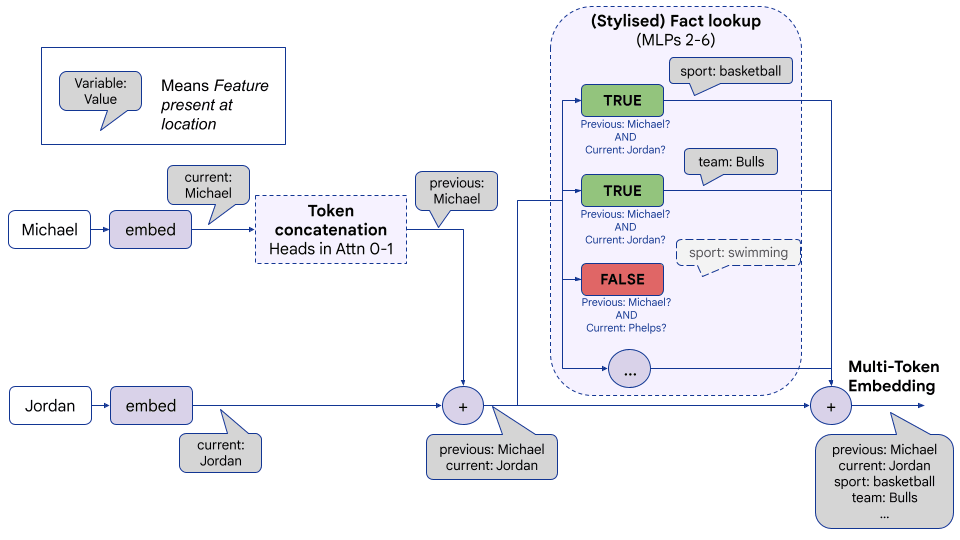
Our main contributions:
Post 2: Simplifying the circuit
- We do a deep dive into the specific circuit of how Pythia 2.8B recalls the sports of different athletes. Mirroring prior work, we show that the circuit breaks down into 3 stages:
- Token concatenation: Attention layers 0 and 1 assemble the tokens of the athlete’s name on the final name token, as a sum of multiple different representations, one for each token.
- Fact lookup: MLPs 2 to 6 on the final name token map the concatenated tokens to a linear representation of the athlete’s sport - the multi-token embedding.
- Notably, this just depends on the name, not on the prior context.
- Attribute extraction: A sparse set of mid to late attention heads extract the sport subspace and move it to the final token, and directly connect with the output.
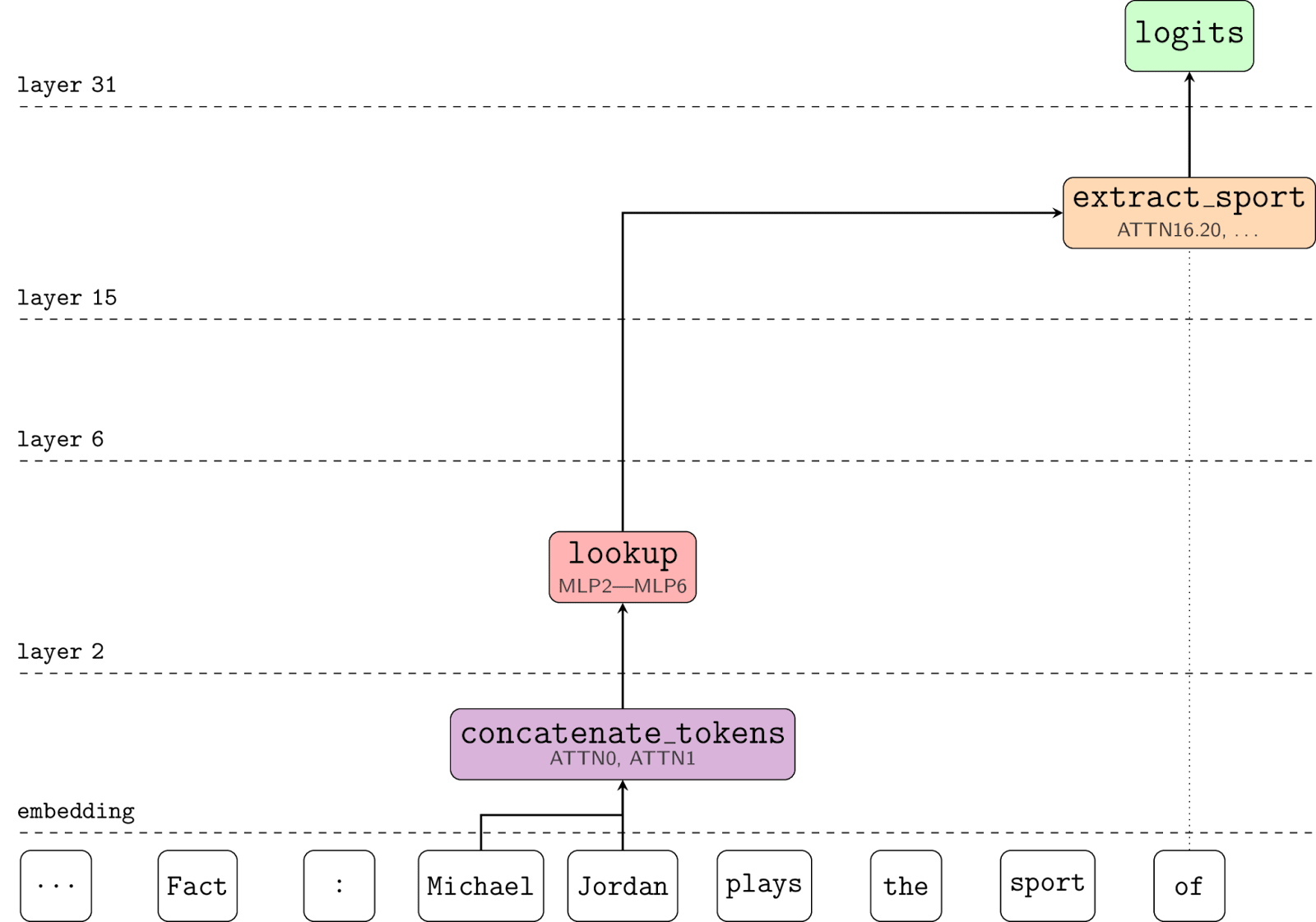
Post 3: Mechanistically understanding early MLP layers
- We zoom in on mechanistically understanding how MLPs 2 to 6 actually map the concatenated tokens to a linear representation of the sport.
- We explore evidence for and against different hypotheses of what’s going on mechanistically in these MLP layers.
- We falsify the naive hypothesis that there’s just a single step of detokenization, where the GELUs in specific neurons implement a Boolean AND on the raw tokens and directly output all known facts about the athlete.
- Our best guess for part of what’s going on is what we term the “hash and lookup” hypothesis, but it’s messy, false in its strongest form and this is only part of the story. We give some evidence for and against the hypothesis.
Post 4: How to think about interpreting memorisation
- We take a step back to compare differences between MLPs that perform generalisation tasks and those that perform memorisation tasks (like fact recall) on toy datasets.
- We consider what representations are available at the inputs and within intermediate states of a network looking up memorised data and argue that (to the extent a task is accomplished by memorisation rather than generalisation) there is little reason to expect meaningful intermediate representations during pure lookup.
Post 5: Do Early Layers Specialise in Local Processing?
- We explore a stronger and somewhat tangential hypothesis that, in general, early layers specialise in processing recent tokens and only mid layers integrate the prior context.
- We find that this is somewhat but not perfectly true: early layers specialise in processing the local context, but that truncating the context still loses something, and that this effect gradually drops off between layers 0 and 10 (of 32).
We also exhibit a range of miscellaneous observations that we hope are useful to people building on this work.
Motivation
Why Superposition
Superposition is really annoying, really important, and terribly understood. Superposition is the phenomenon, studied most notably in Toy Models of Superposition, where models represent more features than they have neurons/dimensions. We consider understanding how to reverse-engineer circuits in superposition to be one of the major open problems in mechanistic interpretability.
Why is it so annoying? Sometimes a circuit in a model is sparse, it only involves a small handful of components (heads, neurons, layers, etc) in the standard basis, and sometimes it’s distributed, involving many components. Approximately all existing mech interp works exploit sparsity, e.g. a standard workflow is identifying an important component (starting with the output logits), identifying the most important things composing with that, and recursing. And we don’t really know how to deal with distributed circuits, but these often happen (especially in non-cherry picked settings!)
Why is it so important? Because this seems to happen a bunch, and mech interp probably can’t get away with never understanding things involving superposition. We personally speculate that superposition is a key part of why scaling LLMs works so well, intuitively, the number of facts known by GPT-4 vs GPT-3.5 scales superlinearly in the number of neurons, let alone the residual stream dimension.
Why is it poorly understood? There’s been fairly limited work on superposition so far. Toy Models of Superposition is a fantastic paper, but is purely looking at toy models, which can be highly misleading - your insights are only as good as your toy model is faithful to the underlying reality. Neurons In A Haystack is the main paper studying superposition in real LLMs, and found evidence they matter significantly for detokenization (converting raw tokens into concepts), but fell short of a real mechanistic analysis on the neuron level.
This makes it hard to even define exactly what we mean when we say “our goal in this work was to study superposition in a real language model”. Our best operationalisation is that we tried to study a circuit that we expected to be highly distributed yet purposeful, and where we expected compression to happen. And a decent part of our goal was to better deconfuse what we’re even talking about when we say superposition in real models. See Toy Models of Superposition and Appendix A of Neurons In A Haystack for valuable previous discussion and articulation of some of these underlying concepts.
Circuit Focused vs Representation Focused Interpretability
To a first approximation, interpretability work often focuses either on representations (how properties of the input are represented internally) or circuits (understanding the algorithms encoded in the weights by which representations are computed and used). A full circuit-based understanding typically requires decent understanding of representations, and is often more rigorous and reliable and can fill in weak points of just studying representations.
For superposition, there has recently been a burst of exciting work focusing on representations, in the form of sparse autoencoders (e.g. Bricken et al, Cunningham et al). We think the success of sparse autoencoders at learning many interpretable features (which are often distributed and not aligned with the neuron basis) gives strong further evidence that superposition is the norm.
In this work, we wanted to learn general insights about the circuits underlying superposition, via the specific case study of factual recall, though it mostly didn’t pan out. In the specific case of factual recall, our recommendation is to focus on understanding fact representations without worrying about exactly how they’re computed.
Why Facts
We focused on understanding the role of early MLP layers to look up facts in factual recall. Namely, we studied one-shot prompts of the form “Fact: Michael Jordan plays the sport of” -> “basketball” for 1,500 athletes playing baseball, basketball or (American) football in Pythia 2.8B. Factual recall circuitry has been widely studied before, we were influenced by Meng et al, Chughtai et al (forthcoming), Geva et al, Hernandez et al and Akyurek et al, though none of these focused on understanding early MLPs at the neuron level.
We think facts are intrinsically pretty interesting - it seems that a lot of what makes LLMs work so well are that they’ve memorised a ton of things about the world, but we also expected facts to exhibit significant superposition. The model wants to know as many facts as possible, so there’s an incentive to compress them, in contrast to more algorithmic tasks like indirect object identification where you can just learn them and be done - there’s always more facts to learn! Further, facts are easy to compress because they don’t interfere with each other (for a fixed type of attribute), the model never needs to inject the fact that “Michael Jordan plays basketball” and “Babe Ruth plays baseball” on the same token, it can just handle the tokens ‘ Jordan’ and ‘ Ruth’ differently (see FAQ questions A.6 and A.7 here for more detailed discussion). We’d guess that a model like GPT-3 or GPT-4 knows more facts than it has neurons.
Further, prior work has shown that superposition seems to be involved in early MLP layers for detokenization, where raw tokens are combined into concepts, e.g. “social security” is a very different concept than “social” or “security” individually. Facts about people seemed particularly in need of detokenization, as often the same name tokens (e.g. a first name or surname) are shared between many unrelated people, and so the model couldn’t always store the fact in the token embeddings. E.g. “Adam Smith” means something very different to “Adam Driver” or “Will Smith”.
Our High-Level Takeaways
How to think about facts?

(Figure from above repeated for convenience)
At a high-level, we recommend thinking about the recall of factual knowledge in the model as multi-token embeddings, which are largely formed by early layers (the first 10-20% of layers) from the raw tokens. The model learns to recognise entities spread across several recent raw tokens, e.g. “| Michael| Jordan”, and produces a representation in the residual stream, with linear subspaces that store information about specific attributes of that entity.
We think that early attention layers perform token concatenation by assembling the raw tokens of these entities on the final token (the “ Jordan” position). And early MLP layers perform fact lookup, a Boolean AND (aka detokenization) on the raw tokens to output this multi-token embedding with information about the described entity. Notably, we believe this lookup is implemented by several MLP layers, and was not localisable to specific neurons or even a single layer.
A significant caveat is that this is extrapolated from a detailed study of looking up athlete facts, rather than a broader range of factual recall tasks, though is broadly supported by the prior literature. Our speculative prediction is that factual recall of the form “recognise that some entity is mentioned in the context and recall attributes about them” looks like this, but more complex or sophisticated forms of factual recall may not (e.g. multi-hop reasoning, or recall with a richer or more hierarchical structure).
We didn’t make much progress on understanding the internal mechanisms of these early MLP layers. Our take is that it’s fine to just black box these early layers as “the thing that produces the multi-token embeddings” and to focus on understanding the meaningful subspaces in these embeddings and how they’re used by circuits in later layers, and not on exactly how they’re computed, i.e. focusing on the representations. This is similar to how we conventionally think of the token embeddings as a big look-up table. One major difference is that the input space to the token embeddings is a single token, d_vocab (normally about 50,000), while the input to the full model or other sub circuits are strings of tokens, which has a far larger input space. While you can technically think of language models as a massive lookup table, this isn’t very productive! This isn’t an issue here, because we focus on inputs that are the (tokenized) names of known entities, a far smaller set.
We think the goal of mech interp is to be useful for downstream tasks (i.e. understanding meaningful questions about model behaviour and cognition, especially alignment-relevant ones!) and we expect most of the interesting computation for downstream tasks to come in mid to late layers. Understanding these may require taking a dictionary of simpler representations as a given, but hopefully does not require understanding how the simpler representations were computed.
We take this lack of progress on understanding internal mechanisms as meaningful evidence against the goal of fully reverse-engineering everything in the model, but we think mech interp can be useful without achieving something that ambitious. Our vision for usefully doing mech interp looks more like reverse-engineering as much of the model as we can, zooming in on crucial areas, and leaving many circuits as smaller blackboxed submodules, so this doesn’t make us significantly more pessimistic on mech interp being relevant to alignment. Thus we think it is fine to leave this type of factual recall as one of these blackboxed submodules, but note that failing at any given task should make you more pessimistic about success at any future mech interp task.
Is it surprising that we didn’t get much traction?
In hindsight, we don’t find it very surprising that we failed to interpret the early MLP layers (though we’re glad we checked!). Conceptually, on an algorithmic level, factual recall is likely implemented as a giant lookup table. As many students can attest, there simply isn't much structure to capitalise on when memorising facts: knowing that "Tim Duncan" should be mapped to "basketball" doesn't have much to do with knowing that "George Brett" should be mapped to "baseball"; these have to be implemented separately. (We deliberately focus on forms of factual recall without richer underlying structure.)
A giant lookup table has a high minimum description length, which suggests the implementation is going to involve a lot of parameters. This doesn’t necessarily imply it’s going to be hard to interpret: we can conceive of nice interpretable implementations like a neuron per entity, but these seem highly inefficient. In theory there could be interpretable schemes that are more efficient (we discuss, test and falsify some later on like single-step detokenization), but crucially there’s not a strong reason the model should use a nice and interpretable implementation, unlike with more algorithmic tasks like induction heads.
Mechanistically, training a neural network is a giant curve fitting problem, and there are likely many dense and uninterpretable ways to succeed at this. We should only expect interpretability when there is some structure to the problem that the training process can exploit. In the case of fact recall, the initial representation of each athlete is just a specific point in activation space, and there is (almost) no structure to exploit, so unsurprisingly we get a dense and uninterpretable result. In post 4, we also studied a toy model mapping pairs of integers to arbitrary labels where we knew all the data and could generate as much as we liked, and didn’t find the toy model any easier to interpret, in terms of finding internal sparsity or meaningful intermediate states.
Look for circuits building on factual representations, not computing them
In mechanistic interpretability, we can both study features and circuits. Features are properties of the input, which are represented in internal activations (eg, “projecting the residual stream onto direction v after layer 16 recovers the sentiment of the current sentence”). Circuits are algorithms inside the model, often taking simpler features and using them to compute more complex ones. Some works prioritise understanding features, others prioritise understanding circuits, we consider both to be valid approaches to mechanistic interpretability.
In the specific case of factual recall, we tried to understand the circuits by which attributes about an entity were looked up, and broadly failed. We think a reasonably halfway point is for future work to focus on understanding how these looked up attributes are represented, and how they are used by downstream circuits in later layers, treating the factual recall circuits of early layers as a small black-boxed submodule. Further, since the early residual stream is largely insensitive to context before the athlete’s name, fact injection seems the only thing the early MLPs can be doing, suggesting that little is lost from not trying to interpret the early MLP layers (in this context).
What We Learned
We split our investigation into four subsequent posts:
- A detailed analysis of the factual recall circuit with causal techniques, which localises the facts to MLPs 2 to 6 and understands a range of high-level facts about the circuit
- A deep dive into the internal mechanisms of these MLP layers that considers several hypotheses and collects evidence for and against, which attempts to (and largely fails to) achieve a mechanistic understanding from the weights.
- A shorter post exploring toy models of factual recall/memorisation, and how they seem similarly uninterpretable to Pythia, and how this supports conceptual arguments for how factual recall may not be interpretable in general
- A shorter post exploring a stronger and more general version of the multi-token embedding hypothesis: that in general residual streams in early layers are a function of recent tokens, and the further-back context only comes in at mid layers. There is a general tendency for this to happen, but some broader context is still used in early layers
What we learned about the circuit (Post 2 Summary)
-
The high-level picture from Geva et al mostly holds up: Given a prompt like “Fact: Michael Jordan plays the sport of”, the model detokenizes “Michael AND Jordan” on the Jordan token to represent every fact the model knows about Michael Jordan. After layer 6 the sport is clearly linearly represented on the Jordan token. There are mid to late layer fact extracting attention heads which attend from “of” to “Jordan” and map the sport to the output logits (see Chughtai et al (forthcoming) for a detailed investigation of these, notably finding that these heads still attend and extract the athlete’s sport even if the relationship asks for a non-sport attribute).
-
We simplified the fact extracting circuit down to what we call the effective model. For two token athlete names, this consists of attention layers 0 and 1 retrieving the previous token embedding and adding it to the current token embedding. These summed token embeddings then go through MLP layers 2 to 6 and at the end the sport is linearly recoverable. Attention layers 2 onwards can be ablated, as can MLP layer 1.
- The linear classifier can be trained with logistic regression. We also found high performance (86% accuracy) by taking the directions that a certain attention head (Layer 16, Head 20) mapped to the output logits of the three sports: baseball, basketball, football.
-
We simplified our analysis to interpreting the effective model, where the “end” of the model is a linear classifier and softmax between the three sports.
- We think the insight of “once the feature is linearly recoverable, it suffices to interpret how the linear feature extraction happens, and the rest of the circuit can be ignored” may be useful in other circuit analyses, especially given how easy it is to train linear probes (given labelled data).
What we learned about the MLPs (Post 3 Summary)
- Once we’d zoomed in on the facts being stored in MLPs 2 to 6, we formed, tested and falsified a few hypotheses about what was going on:
- Note; These were fairly specific and detailed hypotheses, which were fairly idiosyncratic to my (Neel’s) gut feel about what might be going on. The space of all possible hypotheses is large.
- In fact, investigating these hypotheses made us think they were likely false, in ways that taught us about both how LLMs are working and the nature of the problem’s messiness.
- Single step detokenization hypothesis: There’s a bunch of “detokenization” neurons that directly compose with the raw token embeddings, use their GELU to simulate a Boolean AND for e.g. prev==Michael && curr==Jordan, and output a linear representation of all facts the model knows about Michael Jordan
- Importantly, this hypothesis claims that the same neurons matter for all facts about a given subject, and there’s no intermediate state between the raw tokens and the attributes.
- Prior work suggests that detokenization is done in superposition, suggesting a more complex mechanism than just one neuron per athlete. I hypothesised this was implemented by some combinatorial setup where each neuron detokenizing many strings, and each string is detokenized by many neurons, but each string corresponds to a unique subset of neurons firing above some threshold.
- We’re pretty confident the single step detokenization hypothesis is false (at least, in the strong version, though there may still be kernels of truth). Evidence:
- Path patching (noising) shows there’s meaningful composition between MLP layers, suggesting the existence of intermediate representations.
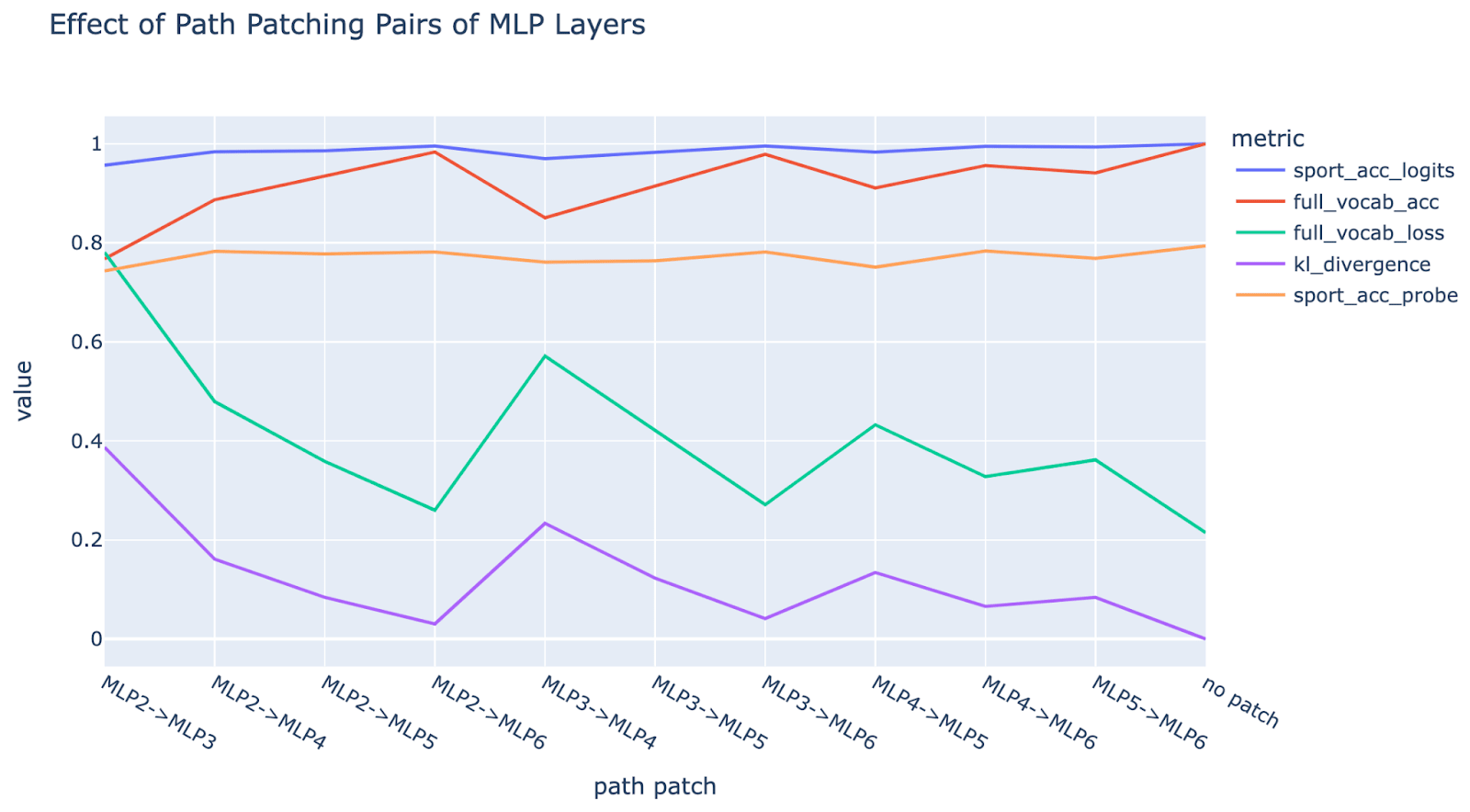
- We collect multiple facts the model knows about Michael Jordan. We then resample ablate (patch) each neuron (one at a time), and measure its effect on outputting the correct answer. The single step detokenization hypothesis predicts that the same neurons will matter for each fact. We measure the correlation between the effect on each pair of facts, and observe little correlation, suggesting different mechanisms for each fact.
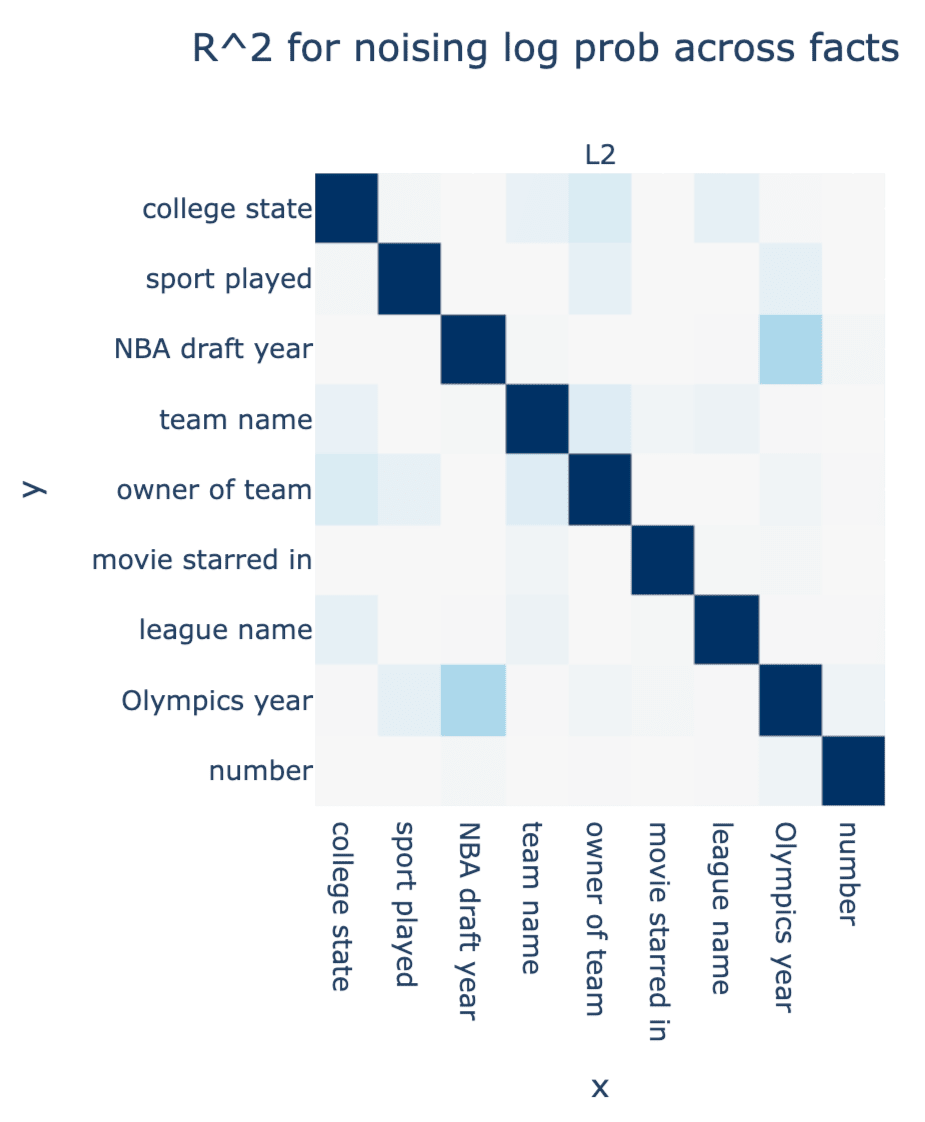
-
By measuring the non-linear effect of each neuron (how much it activates more for Michael Jordan than e.g. Keith Jordan or Michael Smith), we see that the neurons directly connecting with the probe already had a significant non-linear effect pre-GELU. This suggests that they compose with early neurons that compute the AND rather than the neurons with direct effect just computing the AND itself, i.e. that there are important intermediate states
-
Hash and lookup hypothesis: where the first few MLPs “hash” the raw tokens of the athlete into a gestalt representation of the name that’s almost orthogonal to other names, and then neurons in rest of the MLPs “look up” these hashed representations by acting as a lookup table mapping them to their specific sports.
- One role the hashing could serve is breaking linear structure between the raw tokens
- E.g. “Michael Jordan” and “Tim Duncan” play basketball, but we don’t want to think that “Michael Duncan” does
- In other words, this lets the model form a representation of “Michael Jordan” that is not necessarily similar to the representations of “Michael” or “Jordan”
- Importantly, hashing should work for any combination of tokens, not just ones the model has memorised in training, though looking up may not work for unknown names.
-
We’re pretty confident that the strong version of the hash and lookup hypothesis is false, though have found it a useful framework and think there may be some truth to it. Unfortunately “there’s some truth to it, but it’s not the whole story” turned out to be very hard to prove or falsify. Evidence:
-
(Negative) If you linearly probe for sport on the residual stream, validation accuracy improves throughout the “hashing” layers (MLPs 2 to 4), showing there can’t be a clean layerwise separation between hashing and lookup. Pure hashing has no structure, so validation accuracy should be at random during the intermediate hashing layers.
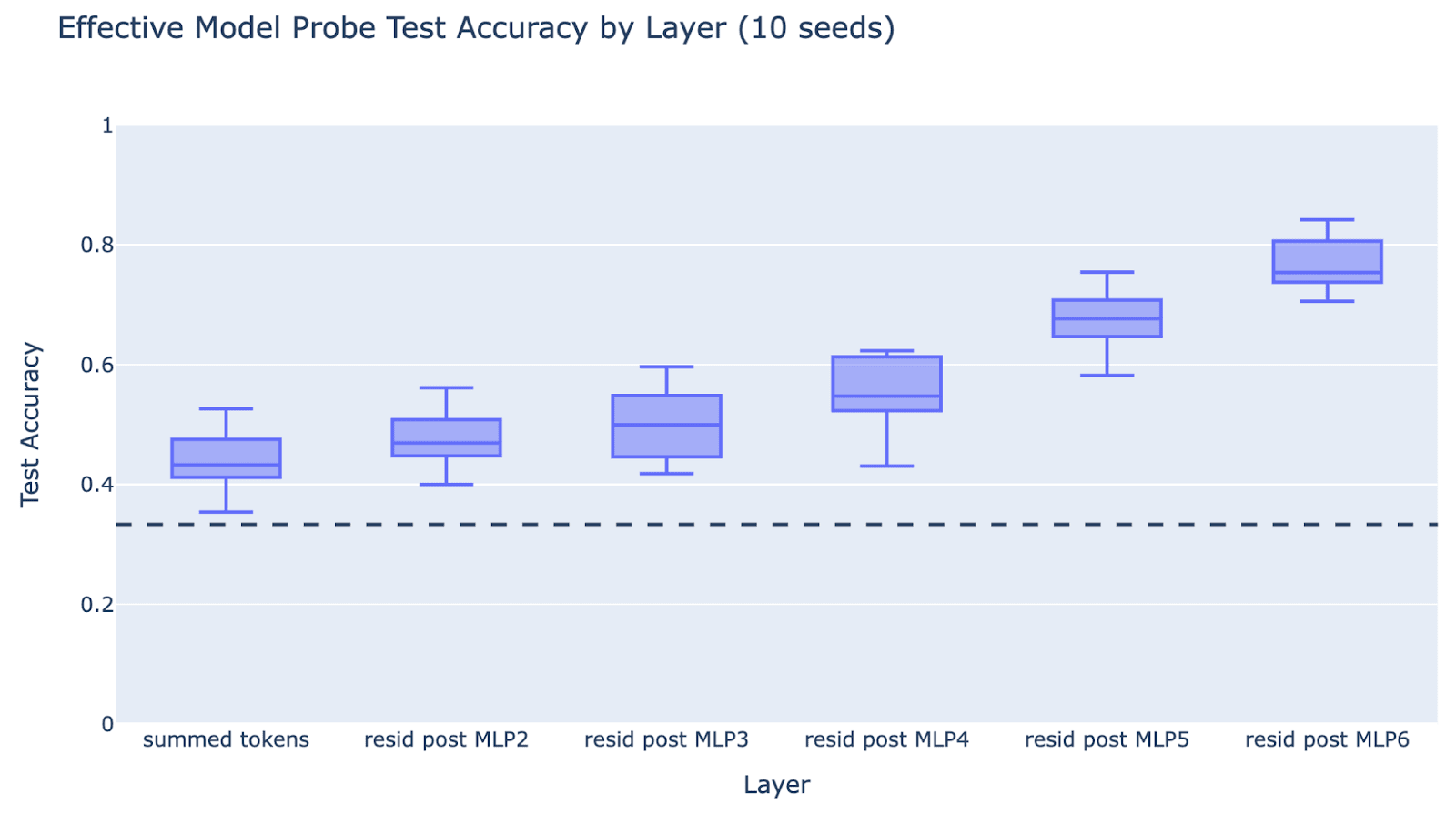
- (Negative) Known names have higher MLP output norm than unknown names even at MLP1 and MLP2 - it doesn’t treat known and unknown names the same. MLP1 and MLP2 are hashing layers, so the model shouldn’t distinguish between known and unknown names this early. (This is weak evidence since there may e.g. be an amortised hash that has a more efficient subroutine for commonly-hashed terms, but still falsifies the strong version of the hypothesis, that hashing occurs with no regard for underlying meaning.)
- (Positive) The model does significantly break the linear structure between tokens. E.g. there’s a significant component on the residual for “Michael Jordan” that’s not captured by the average of names like “Michael Smith” or “John Jordan”. This is exactly what we expect hashing to do.
* However, this is not strong evidence that the main role of MLP layers is to break linear structure, they may be doing a bunch of other stuff too. Though they do break linear structure significantly more than randomly initialised layers
- We found a baseball neuron (L5N6045) which activated significantly more on the names of baseball playing athletes, and composed directly with the fact extracting head
- The input and output weights of the neuron have significant cosine sim with the head-mediated baseball direction (but it’s significantly less than 1): it’s partially just boosting an existing direction, but partially doing something more
- If you take the component of every athlete orthogonal to the other 1500 athletes, and project those onto the baseball neuron, it still fires more for baseball players than other players, maybe suggesting it is acting as a lookup table too.
- Looking on a broader data distribution than just athlete names, it often activates on sport-related things, but is not monosemantic.
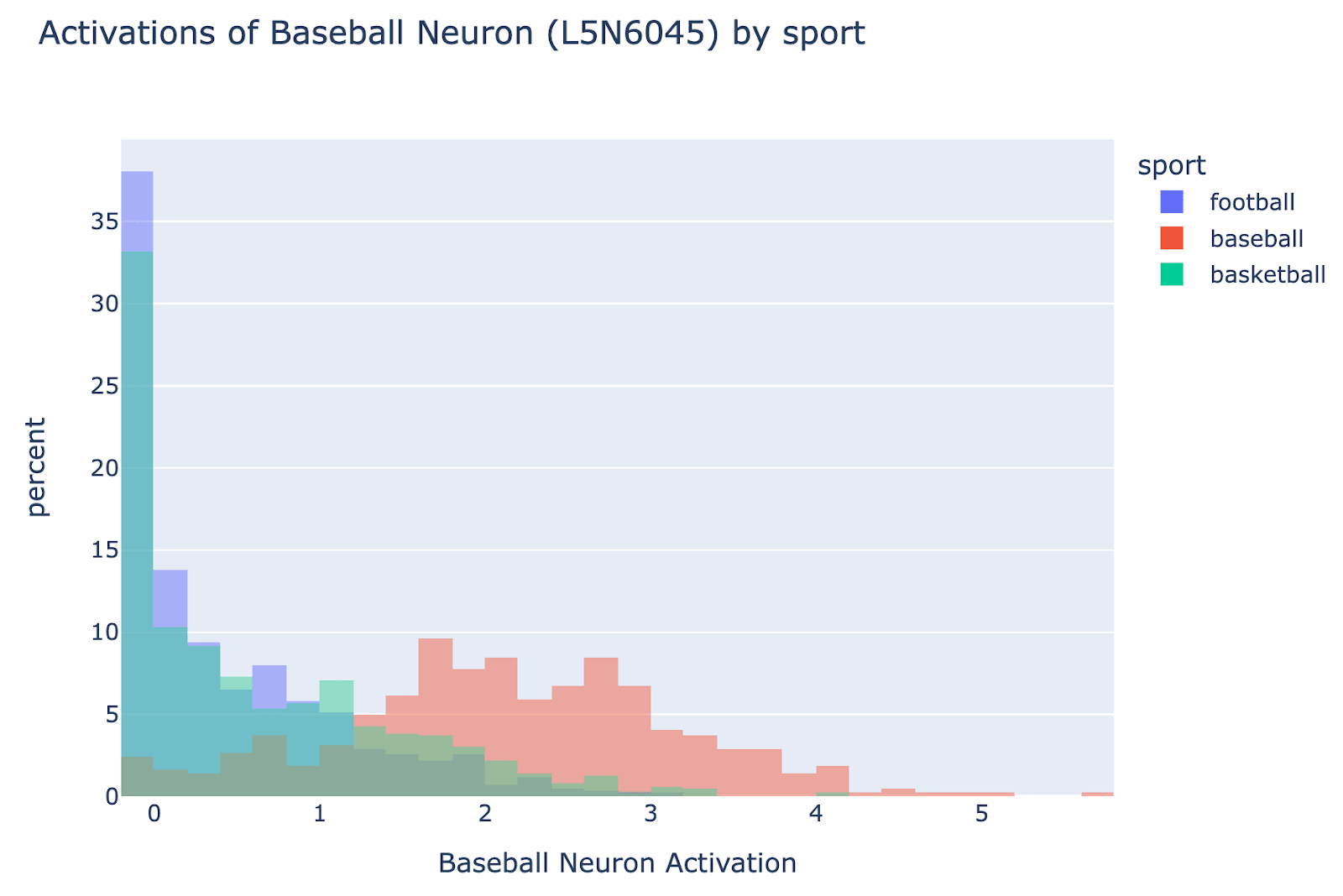
How to Think About Interpreting Memorisation (Post 4 Summary)
This is a more philosophical and less rigorous post, thinking about memorisation and the modelling assumptions behind it, that was inspired by work with toy models, but has less in the way of rigorous empirical work.
-
Motivation:
- When we tried to understand mechanistically how the network does the “fact lookup” operation, we made very little progress.
- What should we take away from this failure about our ability to interpret MLPs in general when they compute distributed representations? In particular, what meaningful representations could we have expected to find in the intermediate activations of the subnetwork?
-
In post 4, we study toy models of memorisation (1-2 MLP layers mapping pairs of integers to fixed and random binary labels) to study memorisation in a more pure setting. The following is an attempt to distil our intuitions following this investigation, we do not believe this is fully rigorous, but hope it may be instructive.
-
We believe one important aspect of fact lookup, as opposed to most computations MLPs are trained to do, is that it mainly involves memorisation: there are no general rules that help you guess what sport an athlete plays from their name alone (at least, with any great accuracy).
-
If a network solves a task by generalisation, we may expect to find representations in its intermediate state corresponding to inputs and intermediate values in the generalising algorithm that it has implemented to solve the task.
-
On the other hand, if a network is unable to solve a task by generalisation (and hence has to memorise instead), this indicates that either no generalising algorithm exists, or at least that none of the features useful for implementing a possible generalising algorithm are accessible to the network.
-
Therefore, under the memorisation scenario, the only meaningful representations (relevant to the task under investigation) that we should find in the subnetwork’s inputs and intermediate representations are:
- Representations of the original inputs themselves (e.g. we can find features like “first name is George”).
- Noisy representations of the target concept being looked up: for example, the residual stream after the first couple of MLP layers contains a noisier, but still somewhat accurate, representation of the sport played, because it is a partial sum of the overall network’s output.
-
On the other hand, on any finite input domain – such as the Cartesian product of all first name / last name tokens – the output of any model component (neuron, layer of neurons, or multiple layers of neurons) can be interpreted as an embedding matrix: i.e. a lookup table individually mapping every first name / last name pair to a specific output vector. In this way, we could consider the sport lookup subnetwork (or any component in that network) as implementing a lookup table that maps name token pairs to sport representations.
-
In some sense, this perspective provides a trivial interpretation of the computation performed by the MLP subnetwork: the weights of the subnetwork are such that – within the domain of the athlete sport lookup task – the subnetwork implements exactly the lookup table required to correctly represent the sport of known athletes. And memorisation is, in a sense by definition, a task where there should not be interesting intermediate representations to interpret.
Do Early Layers Specialise in Local Processing? (Post 5 Summary)
- Motivation
-
The multi-token embedding hypothesis suggests that an important function of early layers is to gather together tokens that comprise a semantic unit (e.g. [ George] [ Brett]) and “look up” an embedding for that unit, such that important features of that unit (e.g. “plays baseball”) are linearly recoverable.
-
This got us thinking: to what extent is this all that early layers do?
-
Certainly, it seems that many linguistic tasks require words / other multi-token entities to be looked up before language-level processing can begin. In particular, many words are split into multiple tokens but seem likely better thought of as a single unit. Such tasks can only be accomplished after lookup has happened, i.e. in later layers.
-
On the other hand, there is no reason to wait until multi-token lookup is finished for single-token level processing (e.g. simple induction behaviour) to proceed. So it’s conceivable that early layers aren’t all about multi-token embedding lookup either: they could be getting on with other token-level tasks in parallel to performing multi-token lookup.
-
If early layers only perform multi-token lookup, an observable consequence would be that early layers’ activations should primarily be a function of nearby context. For multi-token lookup to work, only the few most recent tokens matter.
- So, to measure the extent to which early layers perform multi-token lookup, we performed the following experiment:
- Collect residual stream activations across the layers of Pythia 2.8B for a sample of strings from the Pile.
- Collect activations for tokens from the same strings with differing lengths of truncated context: i.e. for each sampled token, we would collect activations for that token plus zero preceding tokens, one preceding token, etc, up to nine preceding tokens.
- Measure the similarity between the residual stream activations for tokens in their full context versus in the truncated contexts by computing the (mean centred) cosine similarities.
- If early layers only perform local processing, then the cosine similarities between truncated context activations and full context activations should be close to one (at least for a long-enough truncation window).
- Collecting the results, we made the following observations:
- Early layers do perform more local processing than later layers: cosine similarities between truncated and full contexts are clearly high in early layers and get lower in mid to late layers.
- There is a sharp difference though between cosine sims with zero prior context and with some prior context, showing that local layers are meaningfully dependent on nearby context (i.e. they aren’t simply processing the current token).
- However, even at layer 0, local layers do have some dependence on distant context: while cosine sims are high (above 0.9) they aren’t close to 1 (often <0.95).

- Interestingly, we found that truncated vs full context cosine sims for early layers are particularly low on punctuation tokens (periods, commas, newlines, etc) and “stop words” (and, or, with, of, etc) – indicating that early layers perform highly non-local processing on these tokens.
- In retrospect, this isn’t so surprising, as the context immediately preceding such tokens often doesn’t add that much to their meaning, at least when compared to word fragment tokens like [ality], so processing them can start early (without waiting for a detokenisation step first).
- There are several other purposes that representations at these tokens might serve – e.g. summarisation, resting positions, counting delimiters – that could explain their dependence on longer range context.
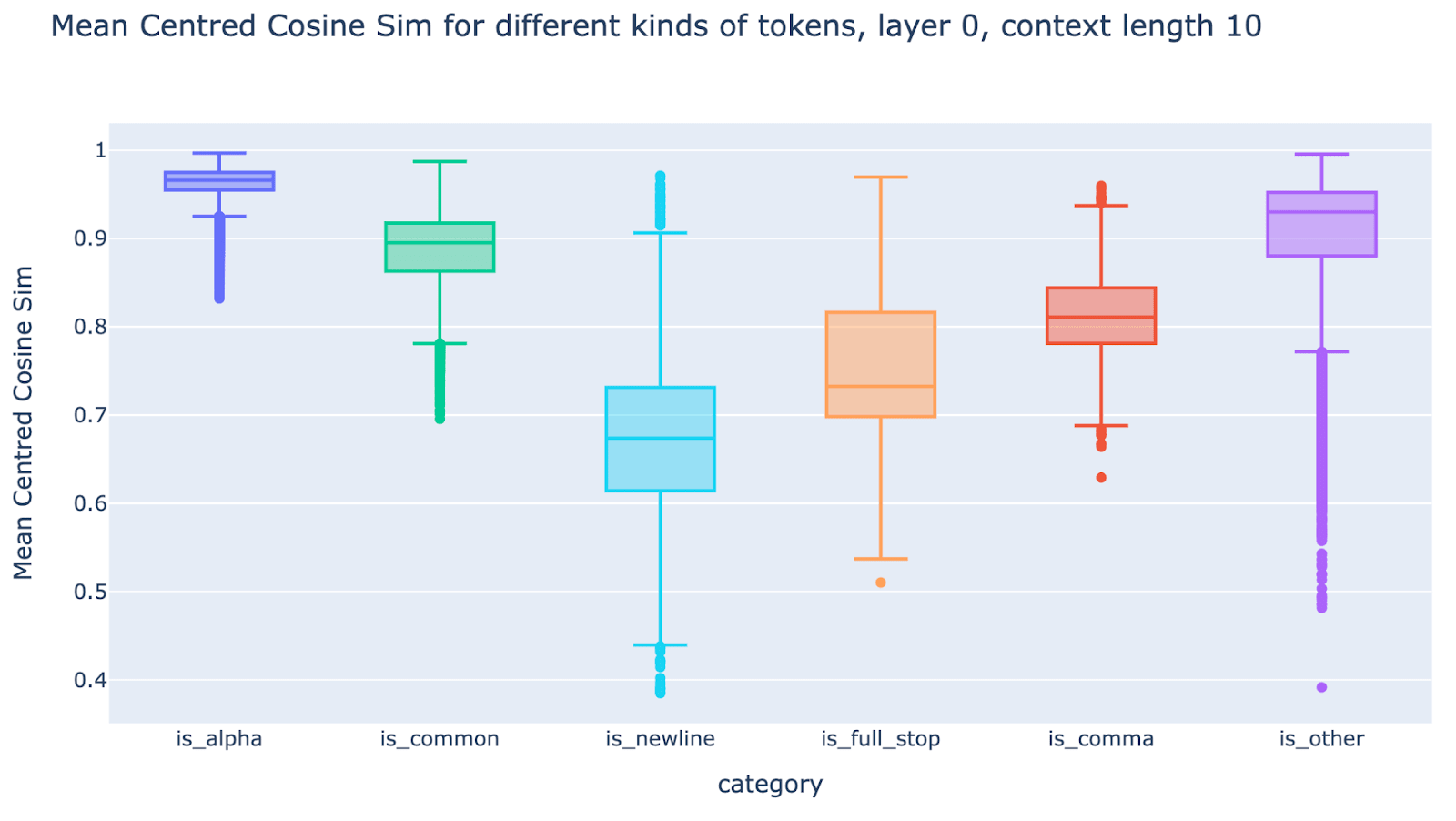
Further Discussion
Do sparse autoencoders make understanding factual recall easier?
A promising recent direction has been to train Sparse Autoencoders (SAEs) to extract monosemantic features from superposition. We haven’t explored SAEs ourselves and so can’t be confident in this, but our guess is that SAEs don’t solve our problem of understanding the circuitry behind fact localisation, though may have helped to narrow down hypotheses.
The core issue is that SAEs are a tool to better understand representations by decomposing them into monosemantic features, while we wanted to understand the factual recall circuit: how do the parameters of the MLP layers implement the algorithm mapping tokens of the names to the sport played? The key missing piece in SAEs is that if meaningful features in MLP layers (pre and post GELU) are not basis aligned then we need (in theory) to understand the function of every neuron in the layer to understand the mapping. In contrast, basis aligned features (i.e. corresponding to a single neuron pre and post GELU) can be understood in terms of a single GELU, and the value of all other neurons is irrelevant.
Understanding representations better can be an extremely useful intermediate step that helps illuminates a circuit, but we expect this to be less useful here. The obvious features an SAE might learn are first name (e.g. “first name is Michael”), last name (e.g. “last name is Jordan”) and sport (e.g. “plays basketball”). It seems fairly likely that there’s an intermediate feature corresponding to each entity e.g. (“is Michael Jordan”) which may be learned by an extremely wide SAE (though it would need to be very wide! There are a lot of entities out there), though we don’t expect many meaningful features corresponding to groups of entities. But having these intermediate representations isn’t obviously enough to understand how a given MLP layer works on the parameter level.
We can also learn useful things from what an SAE trained on the residual stream or MLP activations at different layers can learn. If we saw sharp transitions, where the sport only became a feature after layer 4 or something, this would be a major hint! But unfortunately, we don’t expect to see sharp transitions here, you can probe non-trivially for sport on even the token embeddings, and it smoothly gets better across the key MLP layers (MLPs 2 to 6).
Future work
In terms of overall implications for mech interp, we see our most important claims as that the early MLPs in factual recall implement “multi-token embeddings”, i.e. for known entities whose name consists of multiple tokens, the early MLPs produce a linear representation of known attributes, and more speculatively that we do not need to mechanistically understand how these multi-token embeddings are computed in order for mech interp to be useful (so long as we can understand what they represent, as argued above). In terms of future work, we would be excited for people to red-team and build on our claim that the mechanism of factual lookup is to form these multi-token embeddings. We would also be excited for work looking for concrete cases where we do need to understand tightly coupled computation in superposition (for factual recall or otherwise) in order for mech interp to be useful on a downstream task with real-world/alignment consequences, or just on tasks qualitatively different from factual recall.
In terms of whether there should be further work trying to reverse-engineer the mechanism behind factual recall, we’re not sure. We found this difficult, and have essentially given up after about 6-7 FTE months on this overall project, and through this project we have built intuitions that this may be fundamentally uninterpretable. But we’re nowhere near the point where we can confidently rule it out, and expect there’s many potentially fruitful perspectives and techniques we haven’t considered. If our above claims are true, we’re not sure if this problem needs to be solved for mech interp to be useful, but we would still be very excited to see progress here. If nothing else we expect it would teach us general lessons about computation in superposition which we expect to be widely applicable in models. And, aesthetically, we find it fairly unsatisfying that, though we have greater insight into how models recall facts, we didn’t form a full, parameter-level understanding.
Acknowledgements
We are grateful to Joseph Bloom, Callum McDougall, Stepan Shabalin, Pavan Katta and Stefan Heimersheim for valuable feedback. We are particularly grateful to Tom Lieberum and Sebastian Farquhar for the effort they invested in giving us detailed and insightful feedback that significantly improved the final write-up.
We are also extremely grateful to Tom Lieberum for being part of the initial research sprint that laid the seeds for this project and gave us the momentum we needed to get started.
This work benefited significantly from early discussions with Wes Gurnee, in particular for the suggestion to focus on detokenization of names, and athletes as a good category.
Author Contributions
Neel was research lead for the project, Sen was a core contributor throughout. Both contributed significantly to all aspects of the project, both technical contributions and writing. Sen led on the toy models focused work.
Janos participated in the two week sprint that helped start the project, and helped to write and maintain the underlying infrastructure we used to instrument Pythia. Rohin advised the project.
Citation
Please cite this work as follows
@misc{
nanda2023factfinding,
title={Fact Finding: Attempting to Reverse-Engineer Factual Recall on the Neuron Level},
url={https://www.alignmentforum.org/posts/iGuwZTHWb6DFY3sKB/fact-finding-attempting-to-reverse-engineer-factual-recall},
journal={Alignment Forum},
author={Nanda, Neel and Rajamanoharan, Senthooran and Kram\’ar, J\’anos and Shah, Rohin},
year={2023},
month={Dec}}







